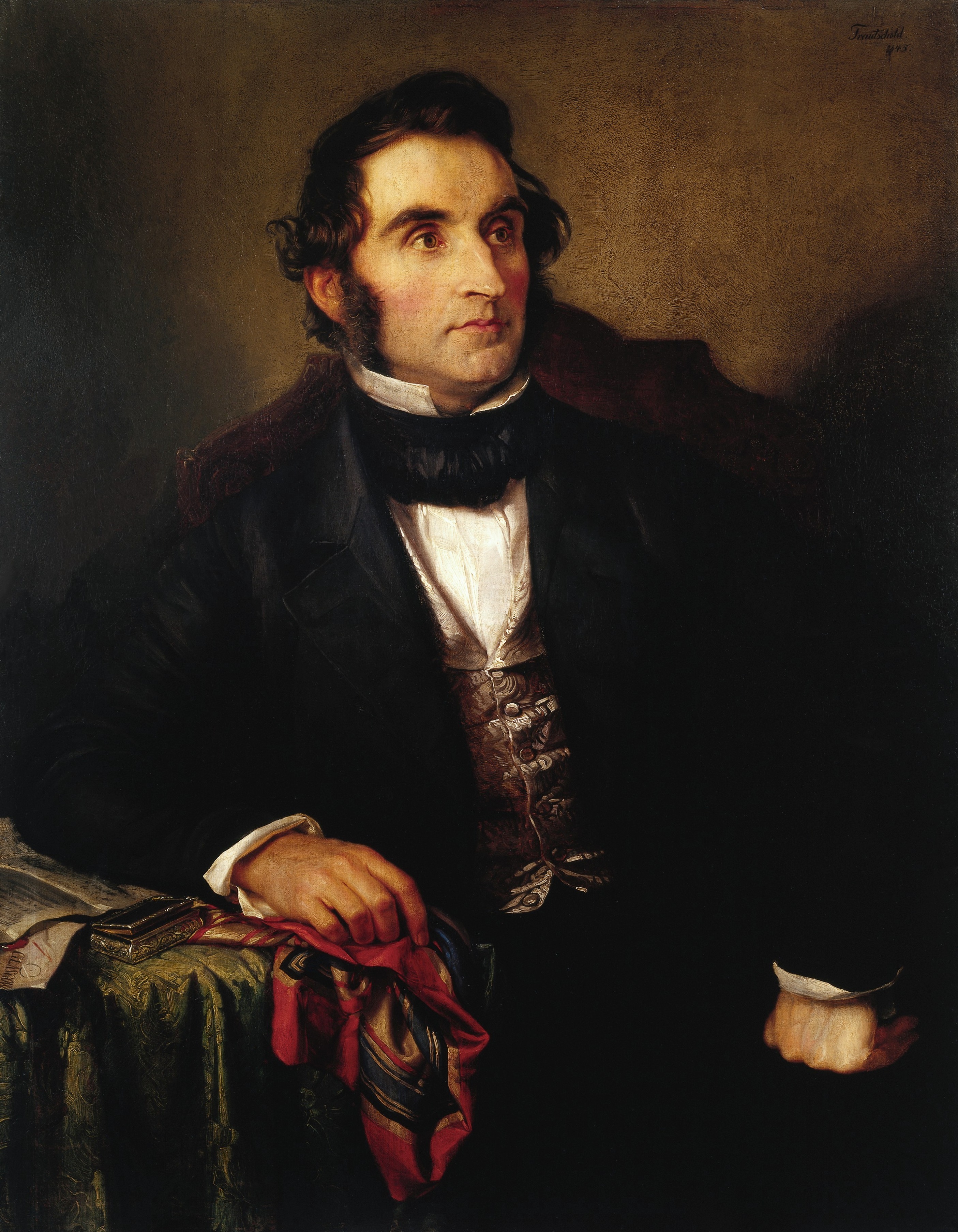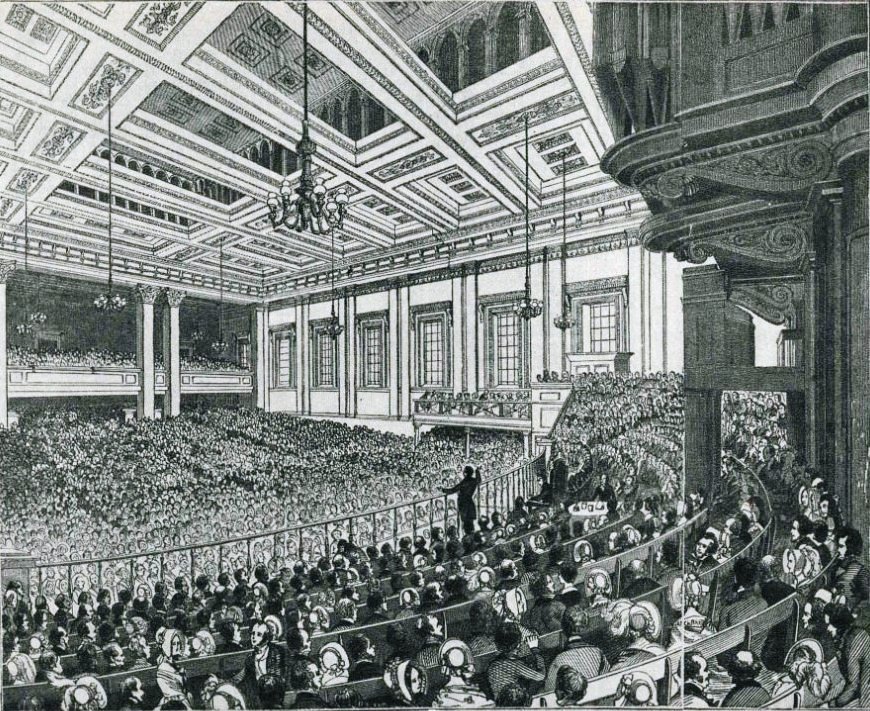|
Maximilian II Of Bavaria
Maximilian II (28 November 1811 – 10 March 1864) reigned as King of Bavaria between 1848 and 1864. Unlike his father, King Ludwig I, "King Max" was very popular and took a greater interest in the business of Government than in personal extravagance. Ascending the throne during the German Revolution of 1848, King Maximilian restored stability in his kingdom. The rest of his reign was characterized by attempts to maintain Bavarian independence during the wars of German Unification and to transform his capital city of Munich into a cultural and educational city. Crown Prince He was born in Munich and was the eldest son of the Crown Prince of Bavaria (later King Ludwig I) and his wife Therese of Saxe-Hildburghausen. After studying at Göttingen and Berlin and travelling in Germany, Italy and Greece, he was introduced by his father into the council of state (1836). From the first he showed a studious disposition, declaring on one occasion that had he not been born in a royal crad ... [...More Info...] [...Related Items...] OR: [Wikipedia] [Google] [Baidu] |
King Of Bavaria
King of Bavaria was a title held by the hereditary Wittelsbach rulers of Bavaria in the state known as the Kingdom of Bavaria from 1805 until 1918, when the kingdom was abolished. It was the second time Bavaria was a kingdom, almost a thousand years after the short-lived Carolingian kingdom of Bavaria. History Under the terms of the Treaty of Pressburg concluded 26 December 1805 between Napoleonic France and Holy Roman Emperor Francis II, several principalities allied to Napoleon were elevated to kingdoms. One of the staunchest of these had been the prince-elector of Bavaria, Maximilian IV Joseph, and on 1 January 1806, he formally assumed the title King Maximilian I Joseph of Bavaria. He was a member of the Wittelsbach branch Palatinate-Birkenfeld-Zweibrücken. Maximilian's successors resisted German nationalism, and Bavaria became the protector of smaller states whose leaders felt threatened by Prussia or Austria in the German Confederation. Religious ties and ... [...More Info...] [...Related Items...] OR: [Wikipedia] [Google] [Baidu] |
Ludwig I, King Of Bavaria
en, Louis Charles Augustus , image = Joseph Karl Stieler - King Ludwig I in his Coronation Robes - WGA21796.jpg , caption = Portrait by Joseph Stieler, 1825 , succession=King of Bavaria , reign = , coronation = , predecessor = Maximilian I Joseph , successor = Maximilian II , birth_name = , birth_date = , birth_place = Strasbourg, Kingdom of France , death_date = , death_place =Nice, Second French Empire , spouse = Therese of Saxe-Hildburghausen , issue =Maximilian II of Bavaria Mathilde Caroline, Grand Duchess of Hesse and by RhineOtto of GreecePrincess TheodelindeLuitpold, Prince Regent of Bavaria Adelgunde, Duchess of Modena Archduchess Hildegard of Austria Princess Alexandra Prince Adalbert , house =Wittelsbach , father =Maximilian I Joseph of Bavaria , mother =Princess Augusta Wilhelmine of Hesse-Darmstadt , religion =Roman Catholicism , burial_place ... [...More Info...] [...Related Items...] OR: [Wikipedia] [Google] [Baidu] |
Justus Von Liebig
Justus Freiherr von Liebig (12 May 1803 – 20 April 1873) was a German scientist who made major contributions to agricultural and biology, biological chemistry, and is considered one of the principal founders of organic chemistry. As a professor at the University of Giessen, he devised the modern laboratory-oriented teaching method, and for such innovations, he is regarded as one of the greatest chemistry teachers of all time. He has been described as the "father of the fertilizer industry" for his emphasis on nitrogen and trace minerals as essential plant nutrients, and his formulation of the law of the minimum, which described how plant growth relied on the scarcest nutrient resource, rather than the total amount of resources available. He also developed a manufacturing process for Meat extract, beef extracts, and with his consent a company, called Liebig Extract of Meat Company, was founded to exploit the concept; it later introduced the Oxo (food), Oxo brand beef bouillon cu ... [...More Info...] [...Related Items...] OR: [Wikipedia] [Google] [Baidu] |
Emanuel Geibel
Emanuel von Geibel (17 October 18156 April 1884) was a German poet and playwright. Life Geibel was born at Lübeck, the son of a pastor. He was originally intended for his father's profession and studied at Bonn and Berlin, but his real interests lay not in theology but in classical and romance philology. In 1838 he accepted a tutorship at Athens, where he remained until 1840. In the same year he published, in conjunction with his friend Ernst Curtius, a volume of translations from Greek. His first poems were published in a volume entitled ''Zeitstimmen'' in 1841. In 1842 he entered the service of Frederick William IV, the king of Prussia, with an annual stipend of 300 thalers; under whom he produced ''König Roderich'' (1843), a tragedy, ''König Sigurds Brautfahrt'' (1846), an epic, and ''Juniuslieder'' (1848), lyrics in a more spirited and manlier style than his early poems. In 1851, Geibel was invited to Munich by Maximilian II of Bavaria as an honorary professor at the unive ... [...More Info...] [...Related Items...] OR: [Wikipedia] [Google] [Baidu] |
Ultramontanes
Ultramontanism is a clerical political conception within the Catholic Church that places strong emphasis on the prerogatives and powers of the Pope. It contrasts with Gallicanism, the belief that popular civil authority—often represented by the monarch's or state's authority—over the Church is comparable to that of the Pope. History The term descends from the Middle Ages, when a non-Italian pope was said to be ''papa ultramontano –'' a pope from beyond the mountains (the Alps).Benigni, Umberto. "Ultramontanism." The Catholic Encyclopedia Vol. 15. New York: Robert Appleton Company, 1912. 6 January 2019 Foreign students at medieval Italian universities also were referred to as ''ultramontani''. After the [...More Info...] [...Related Items...] OR: [Wikipedia] [Google] [Baidu] |
Classical Liberalism
Classical liberalism is a political tradition and a branch of liberalism that advocates free market and laissez-faire economics; civil liberties under the rule of law with especial emphasis on individual autonomy, limited government, economic freedom, political freedom and freedom of speech. It gained full flowering in the early 18th century, building on ideas stemming at least as far back as the 13th century within the Iberian, Anglo-Saxon, and central European contexts and was foundational to the American Revolution and "American Project" more broadly. Notable liberal individuals whose ideas contributed to classical liberalism include John Locke,Steven M. Dworetz (1994). ''The Unvarnished Doctrine: Locke, Liberalism, and the American Revolution''. Jean-Baptiste Say, Thomas Malthus, and David Ricardo. It drew on classical economics, especially the economic ideas as espoused by Adam Smith in Book One of '' The Wealth of Nations'' and on a belief in natural law, prog ... [...More Info...] [...Related Items...] OR: [Wikipedia] [Google] [Baidu] |
Absolute Monarchy
Absolute monarchy (or Absolutism as a doctrine) is a form of monarchy in which the monarch rules in their own right or power. In an absolute monarchy, the king or queen is by no means limited and has absolute power, though a limited constitution may exist in some countries. These are often hereditary monarchies. On the other hand, in constitutional monarchies, in which the authority of the head of state is also bound or restricted by the constitution, a legislature, or unwritten customs, the king or queen is not the only one to decide, and their entourage also exercises power, mainly the prime minister. Absolute monarchy in Europe declined substantially following the French Revolution and World War I, both of which led to the popularization of theories of government based on the notion of popular sovereignty. Absolute monarchies include Brunei, Eswatini, Oman, Saudi Arabia, Vatican City, and the individual emirates composing the United Arab Emirates, which itself i ... [...More Info...] [...Related Items...] OR: [Wikipedia] [Google] [Baidu] |
Prussian Army
The Royal Prussian Army (1701–1919, german: Königlich Preußische Armee) served as the army of the Kingdom of Prussia. It became vital to the development of Brandenburg-Prussia as a European power. The Prussian Army had its roots in the core mercenary forces of Brandenburg during the Thirty Years' War of 1618–1648. Elector Frederick William developed it into a viable standing army, while King Frederick William I of Prussia dramatically increased its size and improved its doctrines. King Frederick the Great, a formidable battle commander, led the disciplined Prussian troops to victory during the 18th-century Silesian Wars and greatly increased the prestige of the Kingdom of Prussia. The army had become outdated by the beginning of the Napoleonic Wars, and France defeated Prussia in the War of the Fourth Coalition in 1806. However, under the leadership of Gerhard von Scharnhorst, Prussian reformers began modernizing the Prussian Army, which contributed greatly to the def ... [...More Info...] [...Related Items...] OR: [Wikipedia] [Google] [Baidu] |
Palatinate (region)
The Palatinate (german: Pfalz; Palatine German: ''Palz'') is a region of Germany. In the Middle Ages it was known as the Rhenish Palatinate (''Rheinpfalz'') and Lower Palatinate (''Unterpfalz''), which strictly speaking designated only the western part of the Electorate of the Palatinate (''Kurfürstentum Pfalz''), as opposed to the Upper Palatinate (''Oberpfalz''). It occupies roughly the southernmost quarter of the German federal state of Rhineland-Palatinate (''Rheinland-Pfalz''), covering an area of with about 1.4 million inhabitants. Its residents are known as Palatines (''Pfälzer''). Geography The Palatinate borders Saarland in the west, historically also comprising the state's Saarpfalz District. In the northwest, the Hunsrück mountain range forms the border with the Rhineland region. The eastern border with Hesse and the Baden region runs along the Upper Rhine river, while the left bank, with Mainz and Worms as well as the Selz basin around Alzey, belong to ... [...More Info...] [...Related Items...] OR: [Wikipedia] [Google] [Baidu] |
Wittelsbacher Palais
The Wittelsbacher Palais was located in Munich at the northeast corner of the Brienner Strasse and the Türkenstraße. Today, a building of the BayernLB is located at the site of the palace. A copy of one of two stone lions at the entrance area is the only keepsake of the palace. History The red brick building, with a Neo Gothic exterior, was built as a royal prince's palace from 1843 to 1848 by Friedrich von Gärtner and Johann Moninger for Crown Prince Maximilian, the later King Maximilian II; After the death of Gärtner the palace was completed by his co-worker Carl Klumpp. From 1848 to 1868 it was the retirement place of King Ludwig I, 1887 to 1918 it served as residence of Ludwig III. At the beginning of August 1914 at the outbreak of the First World War the monarch spoke from the balcony of the Palais to the population. In 1919, it was the meeting place of the Aktionskommittee of the Bavarian Soviet Republic. As of October 1933, it was Headquarters of the Gestapo and ... [...More Info...] [...Related Items...] OR: [Wikipedia] [Google] [Baidu] |
Füssen
Füssen is a town in Bavaria, Germany, in the district of Ostallgäu, situated one kilometre from the Austrian border. The town is known for violin manufacturing and as the closest transportation hub for the Neuschwanstein and Hohenschwangau castles. As of , the town has a population of . History Füssen was settled in Roman times, on the Via Claudia Augusta, a road that leads southwards to northern Italy and northwards to Augusta Vindelicum (today's Augsburg), the former regional capital of the Roman province Raetia. The original name of Füssen was "Foetes", or "Foetibus" (inflected), which derives from Latin "Fauces", meaning "gorge", probably referring to the Lech gorge. In Late Antiquity Füssen was the home of a part of the Legio III Italica, which was stationed there to guard the important trade route over the Alps. Füssen later became the site of the "Hohes Schloss" (High Castle), the former summer residence of the prince-bishops of Augsburg. Below the Hohes Sc ... [...More Info...] [...Related Items...] OR: [Wikipedia] [Google] [Baidu] |


.jpg)


